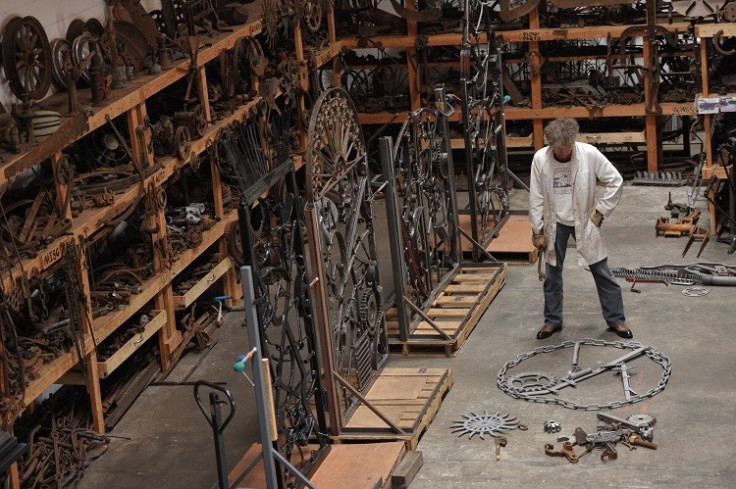Iron Man: Knock, Knock, Knocking on Bob Dylan's Gate

Bob Dylan's guitar, Sunburst Fender Stratocaster, made history at an auction in New York when it sold to the absentee buyer for nearly $1m - the highest price ever paid for a guitar at a Christie's auction.
Around 50 years before, the guitar made rock history when Dylan played it at the 1965 Newport folk festival. The previous record for a guitar sold at auction was Eric Clapton's Fender, which sold at Christie's for $959,500 (£585,411, €696,698) in 2004.
Can his musical oeuvre compete with his iron sculptures exhibited in London? His music is loved by all, but what about his art?
Dylan the Artist
Bob Dylan, our most beloved musician, has taken on iron welding for his new show in London, located just off Bond Street.
Dylan explains, "I've been around iron all my life ever since I was a kid. I was born and raised in Iron ore country - where you could breathe it and smell it every day.
"And I've always worked with it in one form or another. Gates appeal to me because of the negative space they allow. They can be closed but at the same time they allow the seasons and breezes to enter and flow.
"They can shut you out or shut you in. And in some ways there is no difference."
These words are great lyrics for a song that Dylan attempts to translate into visual art. But if you wish to build an iron gate for your garden or entrance, would you employ a proper blacksmith or a singer- songwriter?
The gallery press release states that there is a tendency to judge Dylan, first and foremost, by his musical output and not as an artist in the widest sense, which is what he truly is.
But who is there to judge his artistic merit...you, me, a gallery, or the art world?
Iron Born
Dylan grew up in Hibbing, in an area of Minnesota known as the 'Iron Range' and was surrounded by the influence of industry during his childhood in the region: the hulking machinery and huge workforce going to and from the mines.
As a fan of his music I try hard to find reasons to like his art by exploring Dylan's upbringing, past and motivations; but in vain.
The sculptures appear clumsy, badly crafted, dated, bulky and medieval.
The machinery is welded together with blobs of bronze that look like glue, testament to the fact that Dylan has made these sculptures himself, without relying on a team of assistants.
Each piece has Dylan's signature- a small bronze buffalos- engraved on it, a piece of Americana kitsch.
The kitsch continues in the exhibition as each sculpture carries a price tag sticker.
Everything must go and the prices are not cheap as works range from £30,000 to £200,000.
The installation and exhibition feels dated and naff. We imagine Dylan as the embodiment of the caveman in prehistoric times or Hephaestus, The Greek God of Fire. The Gates are unfashionable and unsophisticated, looking like the entrance of Hell or the entrance to a circus. So run before they shut you in.
As a songwriter and musician, Dylan is an influential figure in popular music and culture and has sold more than 100 million records worldwide and received numerous awards.
However, his reputation in the art world is dubious as his naïve faux paintings and clumsy iron made sculptures feel not part of a current artistic language.
Saying this, we still love Dylan because he pushes the boundaries and he experiments with the unknown, but I would rather carry on listening to his music rather than living with his iron sculptures.
Let's be frank, Dylan is a music genius, but not an Iron Man.
Virginia Damtsa is the co-founder of contemporary art gallery Riflemaker with Tot Taylor. Jake and Dinos Chapman's ''Come and See" exhibition is at the new Serpentine Sackler Gallery designed by Zaha Hadid.
© Copyright IBTimes 2025. All rights reserved.





















